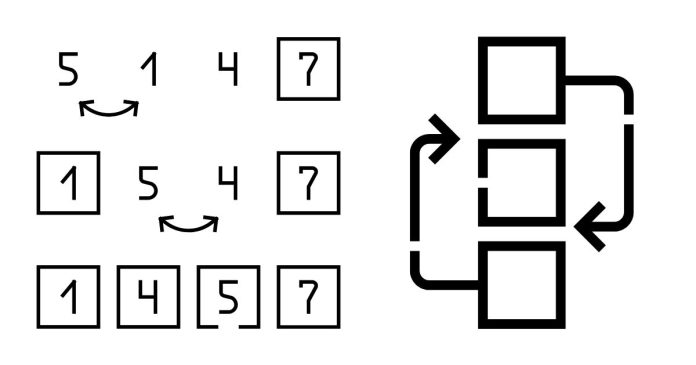Insertion Sort is a simple and intuitive sorting algorithm that works similarly to the way you might sort playing cards in your hand. The algorithm builds the final sorted array one element at a time by comparing and inserting elements into their correct position.
How It Works
The array is conceptually divided into two parts:
- Sorted Part: Initially contains the first element.
- Unsorted Part: Contains the remaining elements.
The algorithm iteratively picks elements from the unsorted part and inserts them into their correct position in the sorted part.
Algorithm Steps
- Start with the second element (index 1) in the array as the key.
- Compare the key with elements in the sorted part (elements before the key).
- Shift all elements in the sorted part that are greater than the key to the right by one position.
- Insert the key into its correct position.
- Repeat this process for all elements in the unsorted part.
Pseudocode
for i = 1 to n-1:
key = array[i]
j = i - 1
while j >= 0 and array[j] > key:
array[j + 1] = array[j]
j = j - 1
array[j + 1] = key
Example
Input: [8, 4, 3, 7, 2]
- Initial Array: [8, 4, 3, 7, 2]
- Step 1 (Key = 4): Compare 4 with 8. Shift 8 to the right and insert 4.
Result: [4, 8, 3, 7, 2] - Step 2 (Key = 3): Compare 3 with 8 and 4. Shift both 8 and 4 to the right and insert 3.
Result: [3, 4, 8, 7, 2] - Step 3 (Key = 7): Compare 7 with 8. Shift 8 to the right and insert 7.
Result: [3, 4, 7, 8, 2] - Step 4 (Key = 2): Compare 2 with all elements. Shift 8, 7, 4, and 3 to the right and insert 2.
Result: [2, 3, 4, 7, 8]
Time Complexity
- Best Case: O(n) (Already sorted array, no shifting needed).
- Worst Case: O(n²) (Reversed array, maximum shifts needed).
- Average Case: O(n²).
Space Complexity
- Space: O(1) (In-place sorting, no additional memory required).
Advantages
- Simple and easy to implement.
- Efficient for small or nearly sorted arrays.
- Stable sorting algorithm (does not change the relative order of equal elements).
Disadvantages
- Not suitable for large datasets due to its quadratic time complexity.
- Performs poorly on reverse-ordered or large unsorted arrays.
Python Implementation
def insertion_sort(array):
for i in range(1, len(array)):
key = array[i]
j = i - 1
# Shift elements of the sorted part that are greater than the key
while j >= 0 and array[j] > key:
array[j + 1] = array[j]
j -= 1
# Insert the key into its correct position
array[j + 1] = key
# Example Usage
arr = [8, 4, 3, 7, 2]
insertion_sort(arr)
print("Sorted Array:", arr)
Output
For the example [8, 4, 3, 7, 2], the sorted array will be:
Sorted Array: [2, 3, 4, 7, 8]


